Deadlift
The deadlift is a weight training exercise in which a loaded barbell or bar is lifted off the ground to the level of the hips, torso perpendicular to the floor, before being placed back on the ground. It is one of the three powerlifting exercises, along with the squat and bench press.
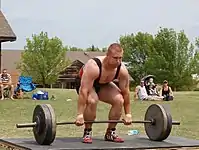
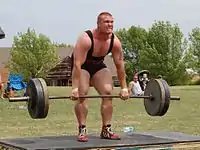
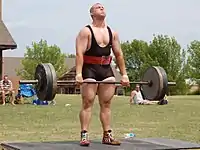
Depending on which style one chooses to use, different muscles will be targeted. For example, with a conventional stance, the back, hamstrings, and glutes will be targeted primarily. With a sumo stance, the quads and glutes will be primarily targeted.
Performing
Form

%252C_1.jpg.webp)
%252C_2.jpg.webp)
The conventional deadlift can be broken down into three parts: the setup, the initial pull or drive, and the lockout.[1]
Setup: When performing a deadlift, a lifter sets in a position that eccentrically loads the gluteus maximus, gluteus minimus, biceps femoris, semitendinosus and semimembranosus while the muscles of the lumbar contract isometrically in an effort to stabilize the spine.
- Set behind the bar with it nearly touching the legs.
- Begin by hinging at the hips and knees, setting one's weight predominantly in the heels while maintaining flat feet.
- Maintain the spine long and straight as the hips hinge back, taking care not to allow the knees to track forwards over the toes.
- Grip the bar outside of the legs. It helps with grip strength to grab the bar with one hand facing forwards and the other facing backwards.
- Depress the shoulders away from the ears to load the lats and to generate force throughout the spinal erectors.
Drive: The next section of the deadlift produces the highest amount of force. By pushing down through their heels while simultaneously pushing up and forward with their hips and maintaining a depressed scapula and a long tense spine, an individual can remain safe during this motion. This is considered the most difficult part of the entire movement due to the amount of work required to drive the bar off the ground initially.
- Take a deep diaphragmatic breath and hold it in during the movement, creating an outward pressure on the core to further stabilize the lumbopelvic hip complex and core throughout the motion.
- Keep the muscles of the back contracted tightly in order to maintain a safe posture throughout the motion.
- Drive up and forward with the hips and legs to stand erect and lift the bar.
Lockout: The finish is the most critical aspect of the motion. This requires being totally erect with a neutral spine and forceful hip extension to engage the muscles of the lumbar spine and abdomen in unison with the glutes.
- Drive the hips completely into the bar.
- Contract the glutei and the rectus abdominis to finish the movement with the pelvis in a neutral position. Contracting the glutes as well as the abdominal muscles is critical for lower back health and safety.
Lowering the weight: Performing the above steps in reverse order. As the muscles of the back and core must remain tight throughout the motion, one should simply hinge at the hips and knees to bring the weight down. Lowering the chest towards the knees while keeping the bar close is the safest way to complete the motion.
Common errors
There are a few common errors during the performance of the deadlift. Protracting the shoulders disengages the back muscles which stabilize the spine. Slack should be taken from the bar prior to the lift, by squeezing the back muscles first and straightening the arms; the bar should then be lifted in a smooth motion without jerking. As the objective of a deadlift is to hinge the hips, the knees should not be bent so deeply as to form a squat. If the bar is too far from the lifter, the lifter may compensate by rounding the back or shifting the weight to the front of the foot. Both result in shifting which muscles are used and could cause injury. Rounding the back in general is controversial; it is often recommended that during the lift, the back is flat with a spine neutral. Some lifters prefer to slightly round their back; but an excessively rounded back may result in the load being lifted awkwardly and placing too much stress or pressure on the back, which may lead to injury. The knees should be bent more fully on the descent of the bar to preserve a neutral spine.[2]
Weights
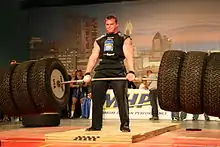
Deadlifts can be performed using dumbbells, barbells, or kettlebells with one hand or two hands, and with one leg or two legs. Other variations are the side deadlift or suitcase deadlift, rack pulls, deadlift lockouts, deficit deadlift or deadlift from a box (pulling from the floor while standing on a built or improvised low platform).
Each of these variations is called for to address specific weaknesses in a lifter's overall deadlift. For instance, if the athlete has difficulty breaking contact at max weight, deficit deadlifts are performed to strengthen the gluteus maximus and hamstrings due to the greater range of motion required by standing on the low platform or low box. On the other hand, if the lifter has no problem with breaking contact with the floor but has difficulty locking out, they should perform rack pulls to strengthen their upper back, posterior deltoids, and trapezius muscles while de-emphasizing the gluteus and hamstrings.
Grips
Typically, there are three grips used: overhand (pronated), a mixed overhand-underhand (supinated) (sometimes called "offset," "staggered," "alternating", or "mixed") grip, or a hook grip. Depending on forearm strength, the overhand grip may result in the bar potentially rolling about. Mixed grip is capable of neutralizing this through the "physics of reverse torsion." The mixed grip allows more weight to be held for this reason.
In order to prevent the bar from rolling out of the hands, some lifters have been known to use an Olympic weightlifting technique known as the hook grip. This is similar to an overhand grip, but the thumbs are inside, allowing the lifter to "hook" onto them with the fingers. The hook grip can make it easier to hold heavier weights using less grip strength, and keeps both shoulders and elbows in a symmetrical position. While it theoretically takes much of the stress off the joints which might be created by the twisting of a mixed grip, it has the disadvantage of being extremely uncomfortable for the thumbs, something which those who advocate it says will pass once a lifter becomes accustomed to it. Another, but rarely used method is a combination of the mixed overhand-underhand grip and the hook grip, preferred by people who lift heavier weights than their grip can handle, but who don't want to rely on lifting straps or other supportive gear.
Many powerlifters adopt the overhand grip for their lower weight sets and move to the mixed grip to lift larger weights so they can achieve their one rep max.
A neutral grip can be achieved by the use of a trap bar; which is a hexagonal shaped bar which the lifter stands inside whilst holding the two side handles. The neutral grip provides the lifter with slightly different posturing which can help reduce the risk of injury.
Muscles involved
A barbell deadlift is a compound exercise and works the gluteus maximus with further work on the quadriceps femoris, hamstrings, trapezius, lats, and erector spinae.[3] The quadriceps, hamstrings, adductor magnus, and soleus serve as synergists during the exercise.[3]
Deadlift variations
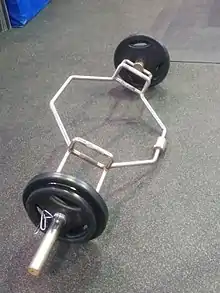
There are numerous variations of the deadlift:[4]
- Stiff-legged deadlift – The grounded-bar start and end positions are modified to make the legs as straight as possible without rounding the back.
- Romanian deadlift – From the standing position, the bar is lowered to about knee-height where the hamstrings are at maximal stretch without rounding the back, developing a natural bend in the legs without squatting, then come to a full lockout position. The Romanian deadlift is named for Nicu Vlad. Because the workout begins from a standing position rather than from a dead stop, it is alternatively called an undead lift.[5]
 Romanian deadlift, step 1
Romanian deadlift, step 1 Romanian deadlift, step 2
Romanian deadlift, step 2
- American deadlift – A variant of the Romanian deadlift, where a hip thrust and glute squeeze is added to the top of the movement.
- Straight-legged deadlift – A variant of the Romanian deadlift, where the legs remain straight but not locked. The back usually needs to be rounded if the bar is taken to the floor.
- Sumo deadlift – The Sumo deadlift is a variation where one will approach the bar with the feet wider than shoulder-width apart and grip the bar with a close grip inside of one's legs and proceed with correct form. Compared to conventional deadlifts, the Sumo deadlift puts more emphasis on the glutes, hamstrings, hips, quads, and traps with less of an impact on spinal erectors and the posterior chain. Weightlifters with a history of back injuries may find that sumo deadlifts are a viable alternative. If allowed in competition, many lifters favor the Sumo deadlift due to shorter bar travel from the floor to lockout.
- Jefferson deadlift - A Jefferson deadlift involves straddling the bar so it is lifted between the legs, with one leg in front and one leg behind.[6]
- Variable resistance deadlift: A variable resistance deadlift commonly involves increasing resistance in the stronger upper phase of the lift and reducing it in the lower weaker phase. This means that the strength phase sequence (strength curve[lower-alpha 1]) which a person moves through during the lift is better matched with the appropriate resistance. This is meant in terms of meeting the same percentage of each phases 1RM e.g. a person’s full rep 1RM is 100kg, including the lower weaker phase, but that is only about 66% of their stronger upper phase 1RM of 150kg. So by increasing resistance in the stronger upper phase they can increase the percentage of that phases 1RM being lifted so that it is more similar to the percentage of the lower weaker phases 1RM being lifted. Resistance may be added gradually through the use of chains or bands which are attached to the ends of the barbell. Bands may also be applied in reverse and hung from a power cage so that when the bar is lowered the bands take some of the weight. Another alternative is to combine heavier partial reps with lighter full reps. Training with variable resistance methods which adjust to take into account the strength curve can help someone to complete lifts faster and more explosively.[7][8]
- Partial rep deadlift: A partial rep involves moving the weight through a partial ROM. Commonly this means lifting a heavier weight than usual but staying within the stronger upper phase[lower-alpha 1] of the lift. This means that the percentage of 1RM lifted for the stronger phase can match more closely the percentage 1RM lifted of the weaker lower phase. For example, a person’s 1RM for a full rep, including the lower weaker phase, is 100kg. And their 1RM for a partial which stays within the stronger upper phase of the movement is 150kg. So the weight lifted for a full rep is only about 66% of a person’s stronger phase 1RM. Combining heavier partials with lighter full reps means the percentage of 1RM met for the stronger and weaker phases respectively can be more consistent. Heavier partial reps can help to increase strength and allow for lifts to be completed faster and more explosively. They can also help to improve a person’s 1RM for a full rep. Partials which entail only the upper part of the lift may involve the barbell being lifted from blocks, or the pins in a power rack (a rack pull). Partial reps can also focus on the lower weaker phase of the movement in order to strengthen this area of the lift specifically and overcome any ‘sticking’ points.[9]
- Trap bar deadlift – The trap bar deadlift is a variation of the deadlift using a special hexagonal bar (a trap bar). This allows more clearance for the knees to pass "through" the bar. To perform the trapbar deadlift, one should load the bar, step inside the hollow portion of the bar, bend down, grasp the handles, stand erect, then lower the bar to the ground in the exact opposite path. This is very helpful for both the handgrip and the lifter's hips.[10] The trap bar deadlift allows for greater amounts of peak force production meaning it can be performed more powerfully. This allows for a greater amount of weight to be lifted than in a traditional barbell deadlift. It also reduces the potential for injury by avoiding excessive strain on the lower back. This is especially advantageous for beginners.[11]
Equipment
A deadlift suit is a special piece of powerlifting assistance clothing. The suits are made from very tight material. The material tightens on the squat on the way down, storing energy, that gives an extra boost with the stored tension to lift up. Thus, records are recorded with and without the suit. The starting position with a suit is slightly different to maximize use, so training with a suit is different. Wrist wraps are sometimes used to provide support, not necessarily to increase lift, like a suit.[12]
Straps can help in a deadlift in case of a weak grip. Figure 8 straps are allowed in some strongman competitions. They allow the lifter to hold the bar in their fingertips and can take over an inch off the pull.[13]
Chains and thick elastic bands can be attached to either end of the barbell in order to increase or descrease resistance at different phases of the lift. This is known as a variable resistance deadlift.
World Records
Men's Records:
- Standard Raw Deadlift (no deadlift suit or straps) - 460.4 kg (1,015 lb) held by Benedikt Magnússon (2011 Hardcore Clash of the Titans IV)[14]
- Raw Sumo Deadlift (no deadlift suit or straps) - 465 kg (1,025 lb) held by Danny Grigsby (2022 USPA Virginia Beach Classic 2)[15]
- Standard Equipped Deadlift (with a deadlift suit and straps) - 501 kg (1,105 lb) held by Hafþór Júlíus Björnsson (World's Ultimate Strongman Feats of Strength series, 2020)[16]
- Elephant Bar Deadlift (with straps) – 474 kg (1,045 lb) held by Hafþór Júlíus Björnsson (2019 Arnold Strongman Classic)[17]
- Hummer Tire Deadlift (with straps) – 545.2 kg (1,202 lb) held by Jean-Francois Caron (2020 Shaw Classic)[18]
- Silver Dollar Deadlift (from 18 inches (45.5 cm)) (with straps) - 537.5 kg (1,185 lb) held by Oleksii Novikov (2020 World's Strongest Man)[19]
Women's Records:
- Standard Raw Deadlift (no deadlift suit or straps) - 305 kg (672 lb) held by Becca Swanson[20]
- Elephant Bar Deadlift (no straps) – 641 lb (291 kg) held by Tamara Walcott (2022 Arnold Sports Festival)[21]
Notes
- A movement may be considered as having any number of strength phases but usually is considered as having two main phases: a stronger and a weaker. When the movement becomes stronger during the exercise, this is called an ascending strength curve i.e. bench press, squat, deadlift. And when it becomes weaker this is called a descending strength curve i.e. chin ups, upright row, standing lateral raise. Some exercises involve a different pattern of strong-weak-strong. This is called a bell shaped strength curve i.e. bicep curls where there can be a sticking point roughly midway.
References
- Rippetoe, Mark (6 December 2011). "Ignorant When it Comes to Deadlifts?". T Nation. Retrieved 26 December 2020.
- DeWitt, Eric (26 April 2014). "Fix the 10 Most Common Deadlift Technique Mistakes". STACK. Retrieved 26 December 2020.
- Ketchum, Dan (1 July 2019). "What Muscles Does a Deadlift Work Out?". LIVESTRONG. Retrieved 26 December 2020.
- Contreras, Bret (19 February 2014). "Romanian Deadlifts, American Deadlifts, Stiff Legged Deadlifts, and Straight Leg Deadlifts". YouTube. Archived from the original on 2021-12-12. Retrieved 26 December 2020.
- Kavadlo, Al (17 November 2009). "Squats and Deadlifts". Al Kavadlo. Retrieved 26 December 2020.
- Somerset, Dean. "How to Do the Jefferson Deadlift". T-Nation. Retrieved 22 March 2021.
- "Accommodating resistance: the deadlift". repelbullies.com.
- Flex Magazine. "Chain Gang: How And Why To Train With Chains". bodybuilding.com. Retrieved 31 March 2021.
- Nuckols, Greg. "Heavy Partials for Size and Strength". T-Nation.com. Retrieved 31 March 2021.
- Madden, Mick (19 August 2013). "Comparing Sumo And Conventional Deadlifts". Muscle and Brawn. Archived from the original on 3 January 2021. Retrieved 19 October 2015.
- "Trap Bar Deadlift Benefits". StronGains. 12 September 2015. Retrieved 26 December 2020.
- Harper, Devin. "Suits, Shirts, Wraps, and Sleeves: A Quick Tutorial on Powerlifting Gear". Breaking Muscle. Retrieved 26 December 2020.
- Beck, Kalle (18 February 2019). "Should An Elephant Bar Deadlift Record Count?". BarBend. Retrieved 26 December 2020.
- Strossen, Randall J. (3 April 2011). "Benedikt Magnusson: 460-kg Deadlift". IronMind. Retrieved 26 December 2020.
- "Danny Grigsby Hits The Heaviest Raw Deadlift of 465 kg (1025 lbs) In Powerlifting History". Fitness Volt. 2022-03-27. Retrieved 2022-03-29.
- "Hafthor Bjornsson: Game of Thrones actor breaks 501kg deadlift record". BBC News. 2 May 2020. Retrieved 26 December 2020.
- Boly, Jake (3 March 2019). "Hafthor Bjornsson Deadlifts A 474kg Elephant Bar World Record (Closely Misses 501kg)". BarBend. Retrieved 26 December 2020.
- Blechman, Phil (18 December 2020). "JF Caron Sets New Hummer Tire Deadlift World Record — 1,202 Pounds". BarBend. Retrieved 26 December 2020.
- Blechman, Phil (15 November 2020). "Oleksii Novikov Leads 2020 World's Strongest Man Finals after Day One". BarBend. Retrieved 16 November 2021.
- "Is Becca Swanson's 672 lb Deadlift the Heaviest Ever by a Woman?". BarBend. 10 December 2018. Retrieved 26 December 2020.
- "World-record powerlifter Tamara Walcott: 'What does 641lbs feel like? It feels light!'". The Guardian. 30 March 2022. Retrieved 30 March 2022.
{{cite web}}: CS1 maint: url-status (link)
Further reading
- Mark Rippetoe with Lon Kilgore, Starting Strength, The Aasgaard Company Publishers, 2005, ISBN 0-9768054-0-5
- Frédéric Delavier, Strength Training Anatomy, Human Kinetics, 2001, ISBN 0-7360-4185-0